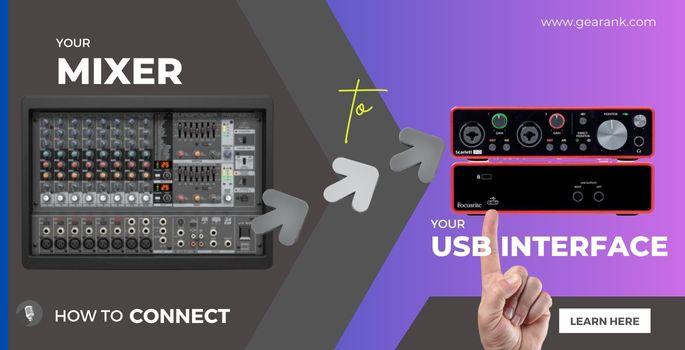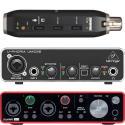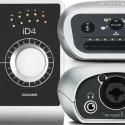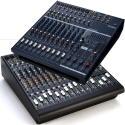Mixer to USB Interface for Audio Recording or Live Streaming

Mixer to USB interface connection lets you turn live music into a digital recording.
A standard part of many home studios, a mixing console receives audio inputs from your instruments and sends them forward into a master channel to stereo outputs.
However, that initial input is in a format your computer can't understand. It's like a different language.
You need something that can act as a translator. In music, these are audio interfaces. They transform the signal into a digital stream you can record and save.
Slight differences in connection can have a significant impact on recording quality. These factors include audio cable type, sampling rate, and bit depth. You must get these connections right for a crisp recording with minimal interference. Read on to discover how to connect inputs, mixers, and interfaces.
Mixer To USB Interface Connection
Sound mixers, audio mixers, DJ mixer systems, and soundboards are different names for the same essential pro audio equipment. This is what you use for sound mixing - to control separate inputs. You can alter and adjust inputs from instruments and microphones with a mixer.
Connecting the mixer to the computer is just the start. The problem is that the two devices speak different "languages." Line mixer inputs are in the form of an analog audio signal. Computers have audio inputs, but these are often just for headsets.
This is where the audio interface comes in. Audio interfaces used to be pieces of hardware built into computers called "sound cards" much like a graphics card. It has since evolved into the external piece of hardware we know today.
An interface changes the "language" of the original recording from analog to digital. It then carries the translation to the computer and your Digital Audio Workstation (DAW). An audio interface will also convert the signal back to analog so you can listen to it via headphones.
The overall idea is pretty simple. An interface acts as a translator from analog to digital. Let's look at the parts of the system before exploring how to make the connections.
Do note that many mixers only output a stereo channel. If you want multiple tracks, your mixer will need individual line outs per channel and the same amount of mic inputs/line inputs on a separate audio interface.
If your mixer doesn't have individual Line level outputs for each channel, connect the stereo outputs into 2 channels on your audio interface. That's all you can do with this type of mixer and interface combination.
Mixer
The mixer board is the central point of the recording studio, from professional operations to your home booth. It comes with EQ (from 3-band EQ to complex multiband EQ), phantom power, and has stereo output.
It would sit between the instruments and master tapes on the recording chain.
Nowadays, it's less common to record to a studio mixer and master tape. Instead, you're much more likely to connect to a computer with a DAW.
The mixer is still an essential point in the recording chain. However, being designed for recording studios, it may not be compatible with your computer. But it can connect to a computer via an analog to digital converter device, like a USB audio interface.
A mixer board typically has a port for an XLR, RCA, or 1/4-inch cable. It will have mic preamps. Setting up several inputs allows for multitrack recording.
The predecessor of the digital mixer is the analog mixer. These have less capability than digital mixers, but some prefer them for their warmth and analog sound.
USB Audio Interface
The audio interface is the next part of the chain unless you're using a digital mixer. It's connected to both the mixer and the computer. Audio interfaces convert the signal from analog to digital. They also convert it back to analog from digital when outputting to speakers or headphones.
Audio interfaces receive the analog signal that the mixing board sends out. They then convert the signal to a digital stream that the computer understands. The amplifier will then convert it back to analog so you can hear it through your headphone output (or speakers).
Many audio interfaces use a USB cable to connect to computers. Other connectors include Firewire and Thunderbolt. Audio interfaces work similar to sound cards, but are more focused on providing good quality audio input.
USB Mixer With Interface
This is the all-in-one option. If you've yet to choose a mixer, I recommend this type. This mixer comes with an audio interface built-in and a USB port. Some even come with an SD card slot for recording.
A mixer with an interface built-in can immediately translate your analog signal to digital. You can plug an input into the mixer and the mixer into the computer. There's no need for an extra step.
One of the main advantages here is ease. There's no audio interface and no additional cables. It's quicker to set up and easier to travel with. Some even allow for USB playback function.
This can also improve the quality of your recording. By cutting out the extraneous components, you reduce places where faults can occur. Having multiple cables outputting from an analog mixer onto an audio interface may develop signal problems down the line, especially with mobile setups.
The major disadvantage is the price. A mixer with an interface is more expensive than a standard mixer. However, the simplification is worth the extra money.
Input And Computer
The input and computer are the start and end points of the chain (not including your speakers).
The input is the musical equipment you connect to your mixer. Most mixers can take multiple inputs at a time. Each will be given a channel that can be controlled on its own.
There's no need for an interface between the input and mixer. However, you have to choose the right type of cable. Different instruments and microphones require other connections. If you try to use the wrong one, the connection won't work, and you might damage your equipment.
At the other end of the chain is the computer. You can save and edit your recording when the computer receives the digital signal.
Choosing A Cable
The cable type will likely be predetermined when connecting the input to the mixer. For example, you'll need a MIDI cable using a synthesizer.
Connecting a mixer to an audio interface is slightly different. There are likely to be several ports, allowing you a choice between cable types. While this might seem like a minor decision, it can affect the quality of your recording.
The most common cable types are:
XLR
An XLR cable is the most expensive option. However, what you get is improved sound quality. With an XLR cable, you can expect less interference, so less noise over a long run.
XLR cables are also balanced cables. The signal travels along two wires. In one wire, the signal is reversed. When it reaches the end, it flips back the polarity, canceling the noise.
RCA
RCA connectors are low-cost and convenient. They're excellent for working on a budget and using old analog equipment. Many old devices only accept RCA.
However, they don't have the same sound quality as the XLR. RCA cables are unbalanced. The signal travels along just one wire. If there's any interference as the signal moves, you can hear it.
This becomes a problem over long cable runs. For that reason, you rarely see RCA cables in professional recording studios. At home, you might not experience an issue.
1/4 Inch (TS or TRS)
A simple and cost-effective option, the 1/4-inch connector is great if you're on a budget. If you're just starting out, using a 1/4-inch cable will allow you to familiarize yourself with the equipment at a minimum cost.
However, you might want to upgrade sooner rather than later. Over long runs, expect interference.
Like the RCA, 1/4-inch cables are considered unbalanced.
1/8 Inch (TRS)
You'll need smaller cables with smaller 1/8" plugs for headphone outputs.
You don't have to worry about cable connections with a USB mixer. USB connectivity is built-in, allowing your audio mixer and DAW to communicate. Having a separate audio interface would be redundant at this point.
Frequently Asked Questions
How Do I Connect An Instrument To A Digital Audio Workstation?
You must connect your instruments to specific audio devices to record at home. You can do so via a mixer and audio interface.
Connect to the mixer with an instrument input, an audio interface, and the computer with DAW.
Another method is using an audio interface directly, especially if they have good preamps.
Do You Need An Audio Interface?
While they may have some similarities, Mixers and Audio Interfaces are different. Audio interfaces translate analog signals to digital signals.
You will need an audio interface if you're using a standard mixer with no USB recording output.
However, you can sometimes bypass the interface if your mixer also functions as an audio interface. Modern home recording studios often circumvent mixers and record straight with an audio interface.
Conclusion
To effectively record your audio input, utilizing a mixer and connecting it to your computer is crucial.
This necessitates a USB audio interface to transform analog signals from the mixer into digital streams for your computer.
For a simple solution, an all-in-one device is worth considering. USB mixers that have built-in interfaces can make digital connections a breeze.
But if you don't have a USB mixer, you can go the mixer to USB interface route. This is the practical choice if you're just getting started, as digital mixers tend to be more expensive.
Audio interfaces offer more flexibility in the long run since many of them can expand their XLR inputs with additional preamps.











